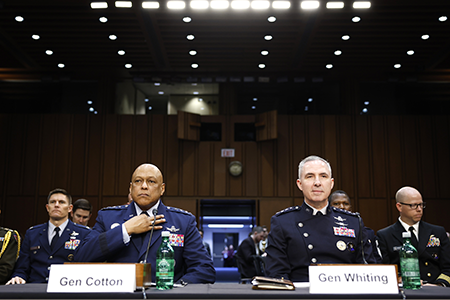"The Arms Control Association’s work is an important resource to legislators and policymakers when contemplating a new policy direction or decision."
STRATCOM Pitches Larger B-21 Fleet
May 2025
By Xiaodon Liang
U.S. generals are calling for an increase in the number of B-21 nuclear-capable strategic bombers that the United States will buy, lauding the aircraft as a rare on-time and under-budget component of an otherwise increasingly troubled nuclear modernization program.

The Air Force should acquire 145 B-21s instead of a planned 100, said Gen. Anthony J. Cotton, head of U.S. Strategic Command, March 18 at an industry conference. Although he and other commanders have hinted previously at recommending an increase to the B-21 program, this was the first time Cotton has explicitly endorsed a higher target. He repeated the recommendation at a March 26 hearing before the Senate Armed Services Subcommittee on Strategic Forces.
Cotton also reiterated a prior call for an acceleration of the B-21 program, which is in low-rate initial production under the supervision of lead contractor Northrop Grumman. The chief executive of the company, Kathy Warden, said on a call April 22 that the firm had already made investments to prepare to speed up production rates, bringing company losses on the bomber to an expected $2 billion over the first five years of production.
The House Armed Services Committee voted April 29 to provide $4.5 billion over the next four years to accelerate B-21 production, as part of a broader budget reconciliation bill.
In an exchange with Senator Mike Rounds (R-S.D.) during the March 26 hearing, Cotton said he was concerned about a significant temporary shortfall—a “bathtub” plunge—in the availability of strategic bombers as the B-2 and B-1 fleets age and retire.
Cotton’s recommendation is backed by some high-ranking Air Force officers. The “demand signal for the bombers is greater than any time I’ve seen in my career,” said Gen. Thomas A. Bussiere, head of Air Force Global Strike Command, at a Dec. 5 Mitchell Institute event.
But other Air Force leaders have been more cautious. A year ago, the service’s chief of staff, Gen. David W. Allvin, declined before the Senate Armed Services Committee to commit to an expansion of the program, noting that available technologies may have changed by the time the planned 100-aircraft production run is completed in the mid-2030s.
President Donald Trump’s nominee to serve as secretary of the Air Force, Troy Meink, suggested openness to reassessing the bomber requirement during his March 27 confirmation hearing before the same Senate committee. The Air Force fleet is “probably too small both on the fighter and the bomber sides of the house,” Meink said.
The B-21 program is “a successful acquisition program by all accounts,” according to Michael Duffey, the nominee for undersecretary of defense for acquisition and sustainment, as he testified alongside Meink March 27.
Duffey’s optimistic view is supported by price estimates published in November 2024 by Aviation Week & Space Technology, which said that the cost to the Air Force of the initial five-years of production has fallen 28 percent from $19.1 billion, as estimated in fiscal year 2023, to $13.8 billion in fiscal 2025. The Defense Department withholds more budgetary and programmatic information about the B-21 than most components of the nuclear modernization effort.
Northrop Grumman received its second year-long, low-rate initial production contract in December. Over the first five contracts, the company is set to build 21 initial aircraft under a fixed-price-plus-incentive reimbursement framework (See ACT, January/February 2025.)
The nuclear-tipped, air-launched cruise missile that the B-21 will deliver, the Long Range Stand Off Weapon, underwent a first flight test in January with its W80-4 warhead, which is in development, according to the Exchange Monitor. The W80-4 program has struggled recently with design issues that could impact its production schedule, according to a January performance evaluation report by the National Nuclear Security Administration, which reviewed work by a key contractor at Lawrence Livermore National Laboratories.
The W80-4 program leadership needs a “focused and disciplined approach” to “avoid program schedule impacts” for the warhead, the evaluation report said.
New delays also are affecting Air Force programs to upgrade the aging B-52H strategic bomber to a new B-52J configuration. According to the annual report of the Pentagon’s director of operational test and evaluation, released in January, the B-52 radar modernization program will now enter production in fiscal 2026 at the earliest. A parallel program to replace the planes’ engines will reach an equivalent milestone in fiscal 2029.
The relative success of the B-21 program stands in contrast to continuing problems with the Columbia ballistic missile submarine and the Sentinel intercontinental ballistic missile (ICBM).
The lead ship of the Columbia class is now 12 to 18 months behind schedule, Navy acquisition leaders said in an April 8 statement to the Senate Armed Services Subcommittee on Seapower and Projection Forces. Work on the second boat of the class remains on schedule, the statement says.
Navy efforts to attract more skilled labor to shipyards have had mixed results, with between 50 and 60 percent of new employees leaving their jobs within the first year, said Brett Seidle, the acting assistant secretary of the Navy for research, development, and acquisition, before the same subcommittee March 26.
As the Air Force reevaluates the scope of the Sentinel ICBM program following a Nunn-McCurdy cost-growth review last year, officials also are weighing the steps needed to keep the Minuteman III ICBM in service through 2050, Bloomberg News reported March 27. The Sentinel is now expected to enter service several years after its target date of 2029. (See ACT, September 2024.)
